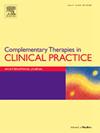虚拟现实对拔除胸管过程中疼痛、焦虑和舒适度的影响:随机临床试验。
IF 2.2
3区 医学
Q2 INTEGRATIVE & COMPLEMENTARY MEDICINE
引用次数: 0
摘要
目的:本研究旨在确定虚拟现实技术对胸管拔除过程中的疼痛、焦虑和舒适度的影响:研究于 2023 年 1 月至 2024 年 4 月在阿塔图尔克大学健康实践与研究医院心血管外科进行。研究以随机对照实验的形式进行,采用前测-后测对照组。82名患者(干预组和对照组各41名)参与了研究。干预组患者在拔除胸管时佩戴虚拟现实眼镜观看视频。研究采用 "描述性信息表"、"视觉模拟量表"、"口头疼痛量表"、"状态焦虑量表 "和 "舒适度量表 "收集数据。数据评估采用了数量、百分比、平均值、标准差、卡方检验、配对样本 t 检验、独立样本 t 检验、曼-惠特尼 U 检验、威尔科克森检验和线性回归分析等方法。我们的研究已录入临床试验数据库,方案编号为 "NCT06550323":两组具有相似的描述性特征(P > 0.05)。两组患者术前平均疼痛、焦虑和舒适度评分相似(P > 0.05)。与对照组相比,干预组的术后平均 VAS 和口头疼痛评分、平均焦虑评分和舒适度评分均较低(P 结论:干预组和对照组的术后平均疼痛评分、平均焦虑评分和舒适度评分均较高(P > 0.05):研究结果表明,虚拟现实技术大大减轻了胸管拔除过程中的疼痛和焦虑,同时提高了舒适度。因此,建议在拔除胸管时使用虚拟现实技术。本文章由计算机程序翻译,如有差异,请以英文原文为准。
The effects of virtual reality on pain, anxiety, and comfort during the chest tube removal procedure: A randomized clinical trial
Purpose
The purpose of the current study is to determine the effects of virtual reality on pain, anxiety, and comfort during chest tube removal.
Materials and methods
The research was conducted in the Cardiovascular Surgery Department of Atatürk University Health Practice and Research Hospital between January 2023 and April 2024. The study was performed as a randomized controlled experimental trial with a pretest-posttest control group. Eighty-two patients (41 in the intervention group and 41 in the control group) were included in the research. Patients in the intervention group watched a video with virtual reality glasses during chest tube removal. The “Descriptive Information Form,” “Visual Analog Scale,” “Verbal Pain Scale,” “State Anxiety Inventory,” and “Comfort Scale” were used to collect data. Number, percentage, mean, standard deviation, chi-square, paired sample t-test, independent sample t-test, Mann-Whitney U test, Wilcoxon test, and linear regression analysis were used in data evaluation. Our study was recorded in the Clinical Trials database with protocol number “NCT06550323.”
Results
The groups had similar descriptive characteristics (p > 0.05). The pre-procedural mean pain, anxiety, and comfort scores were similar in the two groups (p > 0.05). The post-procedural mean VAS and verbal pain scores, mean anxiety, and comfort scores of the intervention group were lower in comparison with the control group (p < 0.05).
Conclusion
The research findings showed that virtual reality significantly reduced pain and anxiety while increasing comfort levels during chest tube removal. Therefore, it is recommended that virtual reality be used during chest tube removal.
求助全文
通过发布文献求助,成功后即可免费获取论文全文。
去求助
来源期刊

Complementary Therapies in Clinical Practice
INTEGRATIVE & COMPLEMENTARY MEDICINE-
CiteScore
6.30
自引率
6.70%
发文量
157
审稿时长
40 days
期刊介绍:
Complementary Therapies in Clinical Practice is an internationally refereed journal published to meet the broad ranging needs of the healthcare profession in the effective and professional integration of complementary therapies within clinical practice.
Complementary Therapies in Clinical Practice aims to provide rigorous peer reviewed papers addressing research, implementation of complementary therapies (CTs) in the clinical setting, legal and ethical concerns, evaluative accounts of therapy in practice, philosophical analysis of emergent social trends in CTs, excellence in clinical judgement, best practice, problem management, therapy information, policy development and management of change in order to promote safe and efficacious clinical practice.
Complementary Therapies in Clinical Practice welcomes and considers accounts of reflective practice.
 求助内容:
求助内容: 应助结果提醒方式:
应助结果提醒方式:


